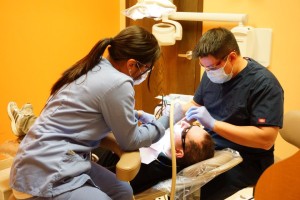Throughout the month of April, we’ve been highlighting the importance of gum health, gum disease treatment, and reasons to address and prevent gum disease (known as gingivitis or periodontitis). Why is the health of your gums so important? Let’s put it right out there: in order to have a truly healthy body, you also need to have healthy gums.
In our previous blog we highlighted some of the body systems and health issues that are directly affected by gum disease, including the respiratory system, pregnancy and reproductive health in women, and heart disease and stroke risk.
With prompt and proper intervention under the care of a dentist and a great home-care oral hygiene routine, gum disease can be addressed, cured and prevented. However, if left unaddressed mild gum disease (gingivitis) can progress to periodontitis. The bacteria associated with gum disease does not always stay in the mouth, and can make its way to other parts of the body through the bloodstream. This is why further research and studies are underway to learn how gum disease may also be connected to other chronic inflammatory conditions such as Rheumatoid Arthritis, as well as heart disease.
Gum Disease Can Be Cured, But Beware of So-Called Do-It-Yourself (DIY) Gum Disease Treatment

DIY “fixes” can do more harm than good. When it comes to gum disease, treatment should be left to a licensed dental professional.
Now that we have proof that gum disease treatment can not only improve your overall health but save hundreds and even thousands of dollars on other health care costs, it makes more sense than ever for people to explore options to do something about their gum disease diagnosis.
In our research we have discovered some websites that claim to offer do-it-yourself gum disease treatment for gum disease symptoms. Some of these “cures” include the use of walnut shells and other abrasives to remove plaque and tartar, and claim to cure gum disease without the need for going to the dentist.
Dr. Sam Azzam, general dentist with 1st Family Dental, reviewed some of the proposed “cures” and found them to be at best unhelpful, and at worst potentially dangerous. Here’s why:
-
 Only a dentist or periodontist (gum specialist) can make a diagnosis and deliver clinical treatment for gum disease. Issues with the gums and soft tissue may also be a sign of another health issue elsewhere in the body, so attempting to self-diagnose could miss something else going on.
Only a dentist or periodontist (gum specialist) can make a diagnosis and deliver clinical treatment for gum disease. Issues with the gums and soft tissue may also be a sign of another health issue elsewhere in the body, so attempting to self-diagnose could miss something else going on. - Gum disease is caused by the collection of bacteria beneath the gums. Using an abrasive material may remove some of the plaque from the surface of the teeth, but will more than likely irritate the soft gum tissue. Some of the particles may even become lodged under the gums, causing further irritation, and worsening the existing condition.
- Gum disease is caused by bacteria that collects beneath the surface of the gums. At home “DIY” treatments only address the surfaces of the teeth, not the underlying cause.
- Anything that irritates the gums further can not only cause more swelling and irritation in the gums, but can also release more of the bacteria into the bloodstream, allowing it to travel through the body and affect other body systems.
- In a clinical setting such as a dental office, procedures and treatments are performed in a clean environment using sterile equipment. Special ultrasonic equipment is designed to remove bacteria from beneath the gum line, without causing irritation. Using abrasive materials at home may introduce even more bacteria into an already vulnerable area, causing more harm than good.
- Removing calculus and bacteria that is lodged under the gums usually requires the use of local anesthesia. That means that attempting something at home could turn out to be quite painful at best, and harmful at worst.
In some cases, gum disease is diagnosed during a regular checkup before it progresses enough to cause noticeable symptoms, and can be cured just by making some modifications to the at-home oral hygiene routine. In other cases, more involved treatments may be required to remove the bacteria. This is why regular dental checkups are so important.
Scaling and Root Planing is one of the most common procedures to address more advanced gum disease. This procedure is also known as a “deep cleaning.” You can learn more about the deep cleaning procedure here.
Gum Disease Treatment Can Drastically Reduce Overall Healthcare Costs
One other very important study showed that addressing gum disease actually improved other health outcomes, resulting in a drastic reduction in healthcare costs! Here are the results:
- Individuals with Type 2 Diabetes reduced their healthcare costs by 40.2%
- People with Cerebral Vascular Disease reduced costs by 40.9%
- Pregnant women reduced their healthcare costs by 73.7% by addressing their gum health issues
This study is proof positive that an investment in the health of your gums is truly an investment in your overall whole-body health! If you take care of your gums, they will take care of you.
Pregnancy Gingivitis Update: Jessica’s Story
In our previous blog, Jessica, one of our contributors, learned she was one of the 40% of women who develop gum disease during their pregnancy. She spent a month keeping track of her oral hygiene routine as well as her overall health to address her pregnancy gingivitis. We are happy to report that after only about 4 weeks of excellent at-home oral hygiene, Jessica’s gingivitis has drastically improved and we expect it to be cured completely shortly after she has her baby. Jessica is proud of her accomplishment, and so are we!
Jessica has learned that the best defense against gum disease is a good offense – which includes flossing every day. Check out her video on how to floss your teeth in 60 seconds or less!



 Only a dentist or periodontist (gum specialist) can make a diagnosis and deliver clinical treatment for gum disease. Issues with the gums and soft tissue may also be a sign of another health issue elsewhere in the body, so attempting to self-diagnose could miss something else going on.
Only a dentist or periodontist (gum specialist) can make a diagnosis and deliver clinical treatment for gum disease. Issues with the gums and soft tissue may also be a sign of another health issue elsewhere in the body, so attempting to self-diagnose could miss something else going on.
Leave a Reply
Comment